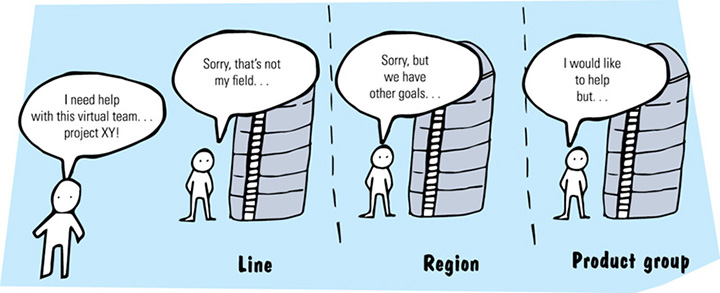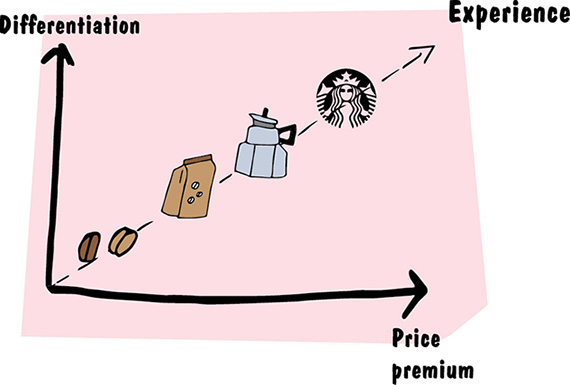2.6 How to prepare the organization for a new mindset
By now, Peter has carried out many projects with design thinking, and innovative and customer-centric solutions have emerged. His environment, his direct supervisors, and colleagues also know that design thinking is an asset for the company. However, Peter notices more and more often that not all teams back the mindset of design thinking.
In discussions with like-minded people, at conferences, or in forums, he realizes that design thinking can bring about relevant solutions; yet many organizations have a hard time disseminating the approach transversally. Resentment grows, and solutions are sought to change the mindset.
At a recent meeting of the DTP community in Zurich, a colleague of Peter’s who was an enthusiastic cyclist came up with an apt metaphor:
“Design thinking is like a fantastic racing bike and it effectively takes us where we haven’t been before! But the fact we own a racing bike does not mean we’ll be able to cross an Alpine pass. We must have the corresponding fitness for it!”
Peter is convinced that his organization—like many other companies—does not have the necessary fitness to live design thinking all the way, with all its consequences.
Upon closer inspection, Peter quickly realizes that his organization has too many departments that do not share the same mindset: Although they have a great racing bike, they have a beer belly and no fitness whatsoever.

The problem Peter shares with others who are responsible for innovation is the form of the organization in which they work. The company has a typical silo structure, which has become manifest over the years and allows management to deal with growing complexity and the requirement for more efficiency. It is made up of specialized teams that optimize their own fitness. The preferred tools are process improvement and operational excellence, which make the silos even more efficient. Transversal collaboration for creating a consistent customer experience falls by the wayside.
To overcome such a silo mentality, we must undertake consciously designed measures and initiate change processes that make cross-departmental collaboration possible. This is the only way to establish a new mindset in an organization as a whole. Design thinking is always only as effective as the capacity of the organization to implement the result comprehensively and evenly.

Many companies have a diversified organizational form in which the individual business units differ greatly and cultivate their own work processes and subcultures. Although this form of organization can help to guide a growing organization into manageable channels, the separation of the organizational elements can result in the fact that the overriding meaning of the company gets lost on the way. The business units and departments see the objectives for their work exclusively in relation to themselves. Objectives that are meaningful to all organizational units are not universally lived. If they do exist, usually they’re only the key financial figures of the company—such as profit and EBIT—which are set for everybody in the company as orientation and corporate objectives.

The consequence is that an integrated and coordinated way of working across the entire organization is quite difficult. Moreover, human, nonfunctional relationships fall by the wayside due to the lack of motivating goals.
The customer experience is becoming the primary product in many segments owing to the transition from industrial manufacturing toward servitization (alignment to goods and services).

Economic success is determined not by the quality of the product but by the fulfillment of our needs across the entire customer experience chain. Customers want an experience—no matter what kind—that they can share with others and that enables them to fulfill their wishes. For this reason, customer centricity is (again) becoming one of the core issues of management in the experience economy. The mindset of design thinking can make a crucial contribution to the development of customer-centric solutions.
Successful businesses gear all their activities and all areas as well as their employees toward the customer. In addition, they integrate the customer and his needs deep in their strategy, such as by creating an enhanced awareness of strategic foresight. They put the focus on customer interaction and the design of worlds of experience.
In many companies, this requires a radical change in the usual understanding of leadership, away from the leadership doctrine of an omnipotent management toward a leadership culture (and a mindset) that enables the organization to overcome this functionally acting structure. The change in the understanding of leadership is also seen as a necessary step toward an integrated organizational form in which employees develop a high degree of intrinsic motivation but, at the same time, direct their activities toward an overriding goal shared by the entire organization.

A unifying and integrating meaning that can be enshrined using the mindset of design thinking helps to implement transformation. As a creative tool, design thinking can fulfill a methodological role in the transformation of the company by providing important tools. The human-centered approach helps to establish orientation toward the customer, which includes considering colleagues from other departments as customers as well. In our experience, effective design thinking can optimally unfold only in an integrated organization.
For organizations that have not yet gathered experience in design thinking, it can help to examine its excellence (its fitness!) in detail before beginning. If we develop design thinking exclusively at the initiative of one single area, it won’t have any lasting effect. From our experience, it is promising to establish the basis for effective design thinking through a company-wide network of users and supporters. This way, design thinking can be disseminated transversally. The buy-in of the decision makers stays as an imperative, though. Management must invest in the development of the capabilities of the entire organization to create an integrated organization.
The ideal is that all employees see themselves as entrepreneurs and act accordingly. Because an integrated and customer-centric company is characterized by the fact that, alongside the company management, the organizational structure and the implementation processes are oriented toward the customers/ecosystem. All employees act on their own responsibility, and the work is meaningful to all involved.
We recommend paying attention to the following elements:
Company management
The company management should place customer centricity as a crucial, strategic theme in the organization and communicate it to all employees. Coupled with a clear vision, it thus empowers all employees to direct themselves fully toward the customer and the ecosystem. For the employees to be able to work independently and in a customer-centric way, management creates a basis of trust. From this basic attitude, a mindset can evolve that gears the strategy toward the attainment of the common goal: to be of service to the customer/ecosystem.
The organizational structure and organizational culture
The organization needs a correspondingly open structure and culture, which are characterized by collaboration. An atmosphere is created in which commitment and a focus on the customer/ecosystem can be lived and experienced. Such an organization facilitates networking and simultaneously a high level of autonomy for all involved. A culture emerges in which collaboration is radical and fast.
Holistic implementation of the customer experience
Customer centricity raises the awareness within the organization for a holistic implementation of the customer experience. To ensure the competitive edge and as a response to changing customer needs, it is pivotal that the whole organization act flexibly—that customer knowledge be quickly and iteratively integrated with improved customer experience chains, and that these experiences be shared with potential partners in the ecosystem.

For change management to result in an integrated and customer- centric organization, we can start with asking how advanced customer centricity is in the company. If customer centricity is still poorly developed, appropriate measures for improvement can be taken. For our example of the racing bike, this means: We build up our muscles purposefully where we need the strength and endurance for our Alpine crossing!

The maturity of customer centricity in an organization can be determined, for instance, by means of self-assessment. Because customer centricity is a feature of the organization as a whole, we should include all employees to determine its maturity. The employees usually know best where the organization can be improved and what should be improved.
The prevailing methods for finding out the degree of development of an organization are general assessments, for instance as part of the EFQM self-assessment or as part of a traditional employee survey. From our experience, approaches such as the Customer Centricity Score™ (CCScore™) are more suitable. In this approach, the focus on the customer is consciously chosen as the starting point of a measurement method. The CCScore™ measures the degree of dissemination of customer centricity in the company. The evaluation is then done on different levels of aggregation of an organization and allows for a differentiated view of how strong customer centricity is and, hence, how “fit” the organization is. On this basis, it can be established where we should begin with the development of the mindset.
Customer centricity is measured mainly with the goal of inferring from the result any specific measures to boost it. Simply to know that we are not comprehensively focused on the customer does not yet change the mindset!
The measurement of customer centricity is similar to a survey on customer satisfaction. If we involve only a few people, the result is patchy. To get to meaningful information, we must question a representative cross-section of the workforce. Much more important than the measurement itself is the dedication that develops from it. Employees must be actively involved in the development of measures. This is the only way they develop their mindset further.
The measurement results only constitute the starting point of a multi-tier process that leads to the targeted improvement of customer centricity. In a closed circuit comprising measurement and inventory, reflection and the development of measures, as well as the subsequent implementation in the organization, causes and effects of improvement measures can be tracked and controlled.
More elements of digital transformation are discussed in Chapter 3.6.
Step 1: Measure the strength
The strength of customer centricity is measured by an online assessment. This allows for a very detailed and differentiated view of the individual drivers behind the CCScore™. It will become quite clear what the individual factors contribute to the overall score of the company and where there is potential for improvement.
Step 2: Infer specific options for action
In a method-based reflection, the causes and drivers of the CCScore™ results are analyzed, translated into relevant strategies for improving customer centricity, and written down. This so-called U procedure is basically a change process, which develops far more than just customer centricity; it enables the company to strengthen the effectiveness of its organization fundamentally and thus lays the cornerstone for effective design thinking.
Step 3: Define an action plan and implement it
To implement the strategies that have emerged, an action plan is drawn up for selected measures. The implementation of the measures is initiated; progress is regularly monitored; and goal attainment is checked in the following CCScore™ measurements. The development of customer centricity can be thus monitored and controlled.
